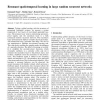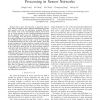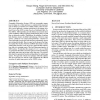1347 search results - page 256 / 270 » On the Structure of the Minimum Time Function |
BC
2002
13 years 7 months ago
2002
Taking a global analogy with the structure of perceptual biological systems, we present a system composed of two layers of real-valued sigmoidal neurons. The primary layer receives...
INFOCOM
2011
IEEE
12 years 11 months ago
2011
IEEE
—Top-k query has long been an important topic in many fields of computer science. Efficient implementation of the top-k queries is the key for information searching. With the n...
ISCA
2011
IEEE
12 years 11 months ago
2011
IEEE
A growing body of work has compiled a strong case for the single-ISA heterogeneous multi-core paradigm. A single-ISA heterogeneous multi-core provides multiple, differently-design...
SIGMOD
2012
ACM
11 years 10 months ago
2012
ACM
End-users increasingly find the need to perform light-weight, customized schema mapping. State-of-the-art tools provide powerful functions to generate schema mappings, but they u...
GIS
2005
ACM
14 years 8 months ago
2005
ACM
Geographic Information Systems (GIS) are increasingly managing very large sets of data and hence a centralized data repository may not always provide the most scalable solution. H...



